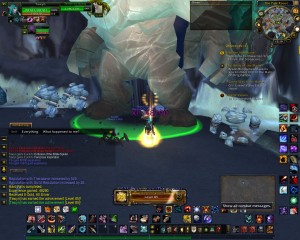 I majored in filmmaking. Yes, that’s right, while the bulk of my friends were busy doing math or science or English courses, I was learning about cinematography and lighting and screenwriting and sound design and watching dozens of movies. (Actually, probably the two courses that taught me the most were the black-and-white darkroom photography class and the “class” where I was the prop manager for an on-stage rendition of “Kimberly Akimbo“, but I digress).
I majored in filmmaking. Yes, that’s right, while the bulk of my friends were busy doing math or science or English courses, I was learning about cinematography and lighting and screenwriting and sound design and watching dozens of movies. (Actually, probably the two courses that taught me the most were the black-and-white darkroom photography class and the “class” where I was the prop manager for an on-stage rendition of “Kimberly Akimbo“, but I digress).
One of the 200-level courses was an editing course and its professor was a guy that most of us loved to poke fun at. The reason is because he was a very proud self-professed “dinosaur” who liked to go into long rambles on how kids these days would just rush into digital editing without ever once touching a real piece of celluloid, and how this was a horrible, terrible loss. Because of this, our big project for this class was to take a bunch of footage that was filmed long, long ago and turn it into a ten-minute long story. Oh and this was “real” film footage– no digital editing allowed.
This project was notorious throughout the school’s film program for the tears it induced; little sketches and cartoons depicting the hellishness of it all hung taped to various shelves in that dark, warm, sticky editing room filled with Moviolas and splicers. There was almost always someone in there working on a project, and everyone was filled with relief when the semester ended and the project was over and we could all safely move on to doing the rest of our school career’s projects on Final Cut Pro.
And so it may shock you to discover my reaction when I discovered not long after that, that my class would be the last ever to do that project– from then on out the school’s program was going completely 100% digital from the start, and no future students would have to do the one token “film editing” assignment.
I felt sad for them.
Because suddenly I realized that in a way, my professor had been right all along. There’s something about actually handling that film footage that teaches you something that is hard to explain. Those future kids wouldn’t get to experience literally being drowned in reels of loose film as you sat on a hard metal foldup chair in that tiny room, bent over your projector, trying your best to imagine your near-microscopic viewing screen was a wall in a theater. They would never get to experience having to think over all your editing choices and weigh them carefully with your instincts before making that splice, because if you later decided you wanted an extra two frames of footage you had to go tape your film back together– no “Undo” buttons here. Those future students would never get to experience all the literal sweat and elbow grease and wouldn’t get to view the joyous celebrations of a group of college kids who would sneak bottles of wine into that infamous room on the night before the project was due, refusing to uncork them until 2 or 3 in the morning when their cut was done and they could wind up your final film with pride, knowing they had just accomplished something very tangible. Because nobody did that in the clean, airy, and yet somehow very sterile computer rooms.
Yeah… my professor was right.
You’re asking why I’m telling this story, and you’re going to giggle at me when I tell you why, but oh well. I’m telling this story because everytime I think of chain trapping and how it seems to be such an un-needed and un-practiced skill these days, I think back to editing class and how once again I feel like one of the last of the old guard.
 Some of my favorite memories in Burning Crusade where when I would go into a heroic with a tank that knew me and maybe a healer who knew me, and then two PuG DPS. The tank would mark up a pull– on a hard pull there would be the tank’s target and then there would be, for example, a sap, and a sheep, and then my beautiful blue square– the trap target.
Some of my favorite memories in Burning Crusade where when I would go into a heroic with a tank that knew me and maybe a healer who knew me, and then two PuG DPS. The tank would mark up a pull– on a hard pull there would be the tank’s target and then there would be, for example, a sap, and a sheep, and then my beautiful blue square– the trap target.
I’d lay down my trap, the rogue would sap, the mage would sheep and then the pull would begin and I’d pull my mob into my trap and pewpew away at the skull. Then skull would be down and the rogue and the mage would run towards my trap… but oh wait, what’s this? The tank is headed at sheep, instead! So we’d all DPS sheep and I’d retrap my target and then the mage and the rogue would rush over to– oh wait, she trapped it again? And the tank, who knew me very well, would go right over to sap without blinking and we’d all DPS sap and then everyone would turn around right as I had finished calmly pulling my mob into yet another trap. At which point the tank would perhaps pause and /dance a bit before finally charging in.
Those moments were beautiful. And every time they happened I grinned to myself and knew I had pulled off a job well done. These days, things are easier and we don’t have a chance to pull that kind of thing off anymore. More than ever before, we are about the fabled Massive Quantities of Sustained Ranged DPS once spoken of by a wise man, and we have little room for anything else. Better? Easier? Your opinion. But as for Professor Pike, who has turned into her editing professor– I think that a hunter who has never trapped before is missing a little piece of knowledge and experience that they would find useful and fulfilling if they learned how, even in today’s world (of Warcraft).
Which is why my hunter kindergarten courses will always contain something on chain trapping, and why my sidebar still links to my Chain Trapping Tutorial Movie. Some of the specifics are different, but the basic gist of it is the same. And I still talk like a dork, so that hasn’t changed either. >.>
Remember: time and space are your friends. Lay your trap out early and use distance to your advantage, because that will buy you more time.
<3
(Oh, and in case you are curious, the title of this post, "In the Blink of an Eye", is the name of a book I read in that class, by master editor Walter Murch. I have long thought there was something very “huntery” about editing (or “editory” about WoW hunters), in that in my mind, both are sort of the unsung heroes of the finished product. Looking through that book recently, I’ve discovered there is actually a chapter called “Misdirection”. I rest my case. =P)



